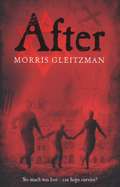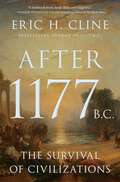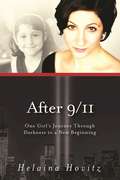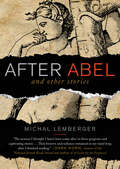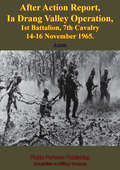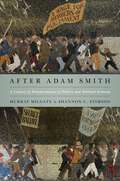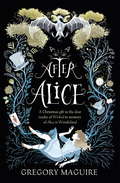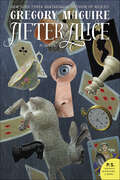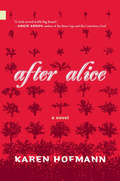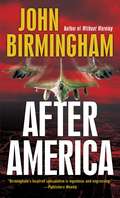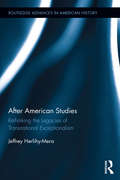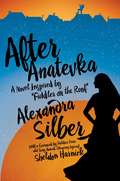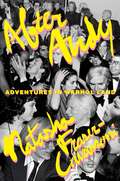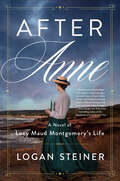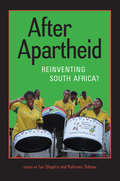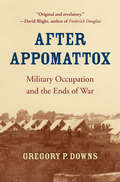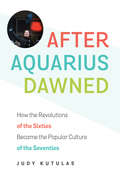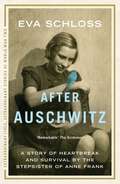- Table View
- List View
After
by Morris GleitzmanAfter is the fourth shocking, funny and heartbreaking book in Morris Gleitzman's Second World War series. After The Nazis took my parents I was scared After They killed my best friend I was angry After They ruined my thirteenth birthday I was determined to get to the forest, to join forces with Gabriek and Yuli, to be a family, to defeat the Nazis after all 'Haunting . . . dangerous and desperate, but also full of courage and hope' - Guardian 'You will laugh . . . prepare for shock and tears' - Sunday Times After is the fourth in a series of children's novels about Felix, a Jewish orphan caught in the middle of the Holocaust, from Australian author Morris Gleitzman - author of Bumface and Two Weeks with the Queen. The other books in the series, Once, Then and Now are also available from Puffin.
After 1177 B.C.: The Survival of Civilizations (Turning Points in Ancient History #12)
by Eric H. ClineIn this gripping sequel to his bestselling 1177 B.C., Eric Cline tells the story of what happened after the Bronze Age collapsed—why some civilizations endured, why some gave way to new ones, and why some disappeared forever&“A landmark book: lucid, deep, and insightful. . . . You cannot understand human civilization and self-organization without studying what happened on, before, and after 1177 B.C.&”—Nassim Nicholas Taleb, bestselling author of The Black SwanAt the end of the acclaimed history 1177 B.C., many of the Late Bronze Age civilizations of the Aegean and Eastern Mediterranean lay in ruins, undone by invasion, revolt, natural disasters, famine, and the demise of international trade. An interconnected world that had boasted major empires and societies, relative peace, robust commerce, and monumental architecture was lost and the so-called First Dark Age had begun. Now, in After 1177 B.C., Eric Cline tells the compelling story of what happened next, over four centuries, across the Aegean and Eastern Mediterranean world. It is a story of resilience, transformation, and success, as well as failures, in an age of chaos and reconfiguration.After 1177 B.C. tells how the collapse of powerful Late Bronze Age civilizations created new circumstances to which people and societies had to adapt. Those that failed to adjust disappeared from the world stage, while others transformed themselves, resulting in a new world order that included Phoenicians, Philistines, Israelites, Neo-Hittites, Neo-Assyrians, and Neo-Babylonians. Taking the story up to the resurgence of Greece marked by the first Olympic Games in 776 B.C., the book also describes how world-changing innovations such as the use of iron and the alphabet emerged amid the chaos.Filled with lessons for today's world about why some societies survive massive shocks while others do not, After 1177 B.C. reveals why this period, far from being the First Dark Age, was a new age with new inventions and new opportunities.
After 9/11: One Girl's Journey through Darkness to a New Beginning
by Jasmin Lee Cori Helaina Hovitz“You are a herald for your generation....Thank you for using your voice to help us make sense of that dark day, and forge a new beginning.”—Hillary Rodham Clinton, in a letter to Helaina Hovitz Helaina Hovitz was twelve years old and in middle school just blocks away when the World Trade Center was attacked. Her memoir encapsulates the journey of a girl growing up with PTSD after living through the events firsthand. After 9/11 chronicles its effects on a young girl at the outset of adolescence, following her as she spirals into addiction and rebellion, through loss, chaos, and confusion.The events of 9/11 were a very real part of Helaina’s life and are still vivid in her memory today. Hundreds were stranded in the neighborhood, including Helaina, without phones or electricity or anyone to help. Fear and despair took over her life. It would take Helaina more than a decade to overcome the PTSD — and subsequent alcohol addiction — that went misdiagnosed and mistreated. In many ways, After 9/11 is the story of a generation growing up in the aftermath of America’s darkest day —and for one young woman, it is the story of a survivor who, after witnessing the end, got to make a new beginning. This new trade paperback edition includes tips on how to cope with trauma, an FAQ section, and a guide to discussing 9/11 with children. “Inspirational, courageous and beautifully told. After 9/11 is a testament to the resiliency of the human spirit.” — Cathy Free, correspondent, PEOPLE magazine“Helaina Hovitz's engrossing narrative begins in the shadow of the twin towers with her as a backpack-toting twelve-year-old and plays out over the next fifteen years in dramatic - and sometimes distressing - detail. This impressive debut is both deeply evocative and intensely personal.” — Peter Canby, Senior Editor, The New Yorker“A moving and remarkable testament to a time that changed our country, told beautifully by a young woman who never gave up hope that she could reclaim her life, no matter how grim things looked.” — Sean Elder, contributor, Newsweek
After 9/11: Solutions For A Saner World
by Don Hazen Tate Hausman Tamara Straus Michelle ChiharaEssays, from the progressive point of view, on various aspects of the 9/11 events, their causes, aftermath and what to do so that all may live in a safer, saner world in the future.
After Abel and Other Stories: And Other Stories
by Jonathan Kirsch Michal Lemberger"Her knowledge of the Bible is evident and her creativity shines through as she weaves nine thoughtful and layered accounts of distant, complicated times."-Publisher's Weekly"Reminiscent of Anita Diamant's The Red Tent. . . . These beautifully written stories feel like meeting Eve, Lot's wife, and many other compelling characters for the first time." -LAUREL CORONA, author of The Mapmaker's Daughter and The Four Seasons: A Novel of Vivaldi's Venice"Stunning." -MOLLY ANTOPOL, author of The UnAmericans"Gorgeous and captivating." -DARA HORN, author of A Guide for the Perplexed and The World to Come"Marvelous." -MICHELLE HUNEVEN, author of Off Course and Blame"What struck me most about these stories is their clear, assured confidence-as if Michal Lemberger had pulled apart some of the lines in the old story, spied a new story tucked in there way off in a corner, shimmied in a fishhook and pulled it out." -AIMEE BENDER, author of The Color Master and The Particular Sadness of Lemon Cake"Lemberger liberates the voices that are trapped beneath the [biblical] text . . . with artistry and erudition." -RABBI DAVID WOLPE, Rabbi of Sinai Temple, Los Angeles and author of Why Faith MattersEve considers motherhood.Miriam tends Moses.Lot's wife looks back.Vividly reimagined with startling contemporary clarity, Michal Lemberger's debut collection of short stories gives voice to silent, oft-marginalized biblical women: their ambitions, their love for their children, their values, their tremendous struggles and challenges. Informed by Lemberger's deep knowledge of the Bible, each of these nine stories story recasts a biblical saga from the perspective of a pivotal woman.Michal Lemberger's nonfiction and journalism have appeared in Slate, Salon, Tablet, and other publications, and her poetry has been published in a number of print and online journals. A story from After Abel, her first collection of fiction, was featured in Lilith Magazine. Lemberger holds an MA and PhD in English from UCLA and a BA in English and religion from Barnard College. She has taught the Hebrew Bible as Literature at UCLA and the American Jewish University. She was born and raised in New York and now lives in Los Angeles with her husband and two daughters.
After Action Report, Ia Drang Valley Operation, 1st Battalion, 7th Cavalry 14-16 November 1965
by Anon."The Battle of Ia Drang was the first major battle between regulars of the United States Army and regulars of the People's Army of Vietnam (PAVN / NVA) of North Vietnam during the Vietnam War. The two-part battle took place between November 14 and November 18, 1965, at two landing zones (LZs) northwest of Plei Me in the Central Highlands of South Vietnam (approximately 35 miles south-west of Pleiku) as part of the U.S. airmobile offensive codenamed Operation Silver Bayonet. The battle derives its name from the Drang River which runs through the valley northwest of Plei Me, in which the engagement took place. Ia means "river" in the local Montagnard language.Representing the American forces were elements of the 3rd Brigade, 1st Cavalry Division: the 1st Battalion and 2nd Battalion of the 7th Cavalry Regiment, and the 2nd Battalion, 5th Cavalry Regiment of the United States Army, facing elements of the B3 Front of the PAVN (including the 304 Division) and Viet Cong. The battle involved close air support by U.S. aircraft and a strategic bombing strike by the B-52s. The initial Vietnamese assault against the landing 1st Battalion, 7th Cavalry at LZ X-Ray was repulsed after two days and nights of heavy fighting on November 14-16. However, the follow-up surprise attack on November 17 that overran the marching column of 7th Cavalry 2nd Battalion near the LZ Albany was the deadliest ambush of a U.S. unit during the course of the entire war. About half of some 300 American deaths in the 35-day Operation Silver Bayonet happened in just this one fight that lasted 16 hours."-Wiki
After Acts: Exploring the Lives and Legends of the Apostles
by Bryan LitfinWhat really happened after Acts?If you&’ve ever wondered what happened to the biblical characters after Acts—from the well-known Matthew to the lesser-known Bartholomew—then this book is for you. Join Dr. Bryan Litfin as he guides you through Scripture and other ancient literature to sift fact from fiction, real-life from legend. Skillfully researched and clearly written, After Acts is as accurate as it is engaging. Gain a window into the religious milieu of the ancient and medieval church. Unearth artifacts and burial sites. Learn what really happened to your favorite characters and what you should truly remember them for.Did Paul ever make it to Spain? Was he beheaded in Rome?Is it true that Peter was crucified upside down?Was the Virgin Mary really bodily assumed into heaven?The book of Acts ends at chapter 28. But its characters lived on.
After Acts: Exploring the Lives and Legends of the Apostles
by Bryan LitfinWhat really happened after Acts?If you&’ve ever wondered what happened to the biblical characters after Acts—from the well-known Matthew to the lesser-known Bartholomew—then this book is for you. Join Dr. Bryan Litfin as he guides you through Scripture and other ancient literature to sift fact from fiction, real-life from legend. Skillfully researched and clearly written, After Acts is as accurate as it is engaging. Gain a window into the religious milieu of the ancient and medieval church. Unearth artifacts and burial sites. Learn what really happened to your favorite characters and what you should truly remember them for.Did Paul ever make it to Spain? Was he beheaded in Rome?Is it true that Peter was crucified upside down?Was the Virgin Mary really bodily assumed into heaven?The book of Acts ends at chapter 28. But its characters lived on.
After Adam Smith: A Century of Transformation in Politics and Political Economy
by Shannon C. Stimson Murray MilgateHow writers after Adam Smith helped shape our thinking about economics and politicsFew issues are more central to our present predicaments than the relationship between economics and politics. In the century after Adam Smith's Wealth of Nations the British economy was transformed. After Adam Smith looks at how politics and political economy were articulated and altered. It considers how grand ideas about the connections between individual liberty, free markets, and social and economic justice sometimes attributed to Smith are as much the product of gradual modifications and changes wrought by later writers.Thomas Robert Malthus, David Ricardo, James Mill, John Stuart Mill, and other liberals, radicals, and reformers had a hand in conceptual transformations that culminated in the advent of neoclassical economics. The population problem, the declining importance of agriculture, the consequences of industrialization, the structural characteristics of civil society, the role of the state in economic affairs, and the possible limits to progress were questions that underwent significant readjustments as the thinkers who confronted them in different times and circumstances reworked the framework of ideas advanced by Smith—transforming the dialogue between politics and political economy. By the end of the nineteenth century an industrialized and globalized market economy had firmly established itself. By exploring how questions Smith had originally grappled with were recast as the economy and the principles of political economy altered during the nineteenth century, this book demonstrates that we are as much the heirs of later images of Smith as we are of Smith himself.Many writers helped shape different ways of thinking about economics and politics after Adam Smith. By ignoring their interventions we risk misreading our past—and also misusing it—when thinking about the choices at the interface of economics and politics that confront us today.
After Alice
by Gregory MaguireAfter Alice by Gregory Maguire, the bestselling author of WICKED, is a wonderful retelling of what happened next after Alice disappeared down the rabbit hole. An entertaining spin on Lewis Caroll's classic tale of Alice in Wonderland, this novel will delight fans of Angela Carter. When Alice fell down the rabbit-hole, she found Wonderland as rife with inconsistent rules and abrasive egos as the world she left behind. But how did Victorian Oxford react to Alice's disappearance?Gregory Maguire turns his imagination to the question of underworlds, undergrounds, underpinnings -and understandings old and new, offering an inventive spin on Carroll's enduring tale. Ada, a friend mentioned briefly in Alice's Adventures in Wonderland, sets out to visit Alice but, arriving a moment too late, tumbles down the rabbit-hole herself. Ada brings to Wonderland her own imperfect apprehension of cause and effect as she embarks on an odyssey to find Alice and bring her safely home from this surreal world below the world. The White Rabbit, the Cheshire Cat and the bloodthirsty Queen of Hearts interrupt their mad tea party to suggest a conundrum: if Eurydice can ever be returned to the arms of Orpheus, or if Lazarus can be raised from the tomb, perhaps Alice can be returned to life. Either way, everything that happens next is After Alice.
After Alice: A Novel
by Gregory MaguireFrom the multi-million-copy bestselling author of Wicked comes a magical new twist on Lewis Carroll’s beloved classic, Alice’s Adventures in Wonderland.When Alice toppled down the rabbit-hole 150 years ago, she found a Wonderland as rife with inconsistent rules and abrasive egos as the world she left behind. But what of that world? How did 1860s Oxford react to Alice’s disappearance?In After Alice, Gregory Maguire turns his dazzling imagination to the question of underworlds, undergrounds, underpinnings—and understandings old and new, offering an inventive spin on Carroll’s enduring tale. Ada, a friend of Alice’s mentioned briefly in Alice’s Adventures in Wonderland, is off to visit her friend, but arrives a moment too late—and tumbles down the rabbit-hole herself.Ada brings to Wonderland her own imperfect apprehension of cause and effect as she embarks on an odyssey to find Alice and see her safely home from this surreal world below the world. If Eurydice can ever be returned to the arms of Orpheus, or Lazarus can be raised from the tomb, perhaps Alice can be returned to life. Either way, everything that happens next is “After Alice.”
After Alice: A Novel (Nunatak First Fiction Series #37)
by Karen Hofmann"After retiring from the heady world of academia, Sidonie von Täler has returned to the small Okanagan Valley town she escaped in her youth for the lights of the big city. The family orchard has since gone to seed, and even decades later Sidonie still finds herself living in the shadow of her deceased older sister Alice. As she gets down to work sifting through the detritus of her family’s legacy, Sidonie is haunted by memories of trauma and triumph in equal measure, and must find a way to reconcile her past and present while reconnecting with the family members she has left. Karen Hofmann’s debut novel blends a poetic sensibility with issues of land stewardship, social stratification and colonialism, painting the geological and historical landscape of the Okanagan in vivid and varied colours."
After America (The Disappearance #2)
by John BirminghamMarch 14, 2003, was the day the world changed forever. A wave of energy slammed into North America and devastated the continent. The U. S. military, poised to invade Baghdad, was left without a commander in chief. Global order spiraled into chaos. Now, three years later, a skeleton U. S. government headquartered in Seattle directs the reconstruction of an entire nation-and the battle for New York City has begun. Pirates and foreign militias are swarming the East Coast, taking everything they can. The president comes to the Declared Security Zone of New York and barely survives the visit. The enemy-whoever they are-controls Manhattan’s concrete canyons and the abandoned flatlands of Long Island. The U. S. military, struggling with sketchy communications and a lack of supplies, is mired in a nightmare of urban combat. Caught up in the violence is a Polish-born sergeant who watches the carnage through the eyes of an intellectual and with the heart of a warrior. Two smugglers, the highborn Lady Julianne Balwyn and her brawny partner Rhino, search for a treasure whose key lies inside an Upper East Side Manhattan apartment. Thousands of miles away, a rogue general leads the secession of Texas and a brutal campaign against immigrants, while Miguel Pieraro, a Mexican-born rancher, fights back. And in England, a U. S. special ops agent is called into a violent shadow war against an enemy that has come after her and her family. The president is a stranger to the military mindset, but now this mild-mannered city engineer from the Pacific Northwest needs to make a soldier’s choice. With New York clutched in the grip of thousands of heavily armed predators, is an all-out attack on the city the only way to save it? From the geopolitics of post-American dominance to the fallout of Israel’s nuclear strike,After Americaprovides a gripping, intelligent, and harrowing chronicle of a world in the maw of chaos-and lives lived in the dangerous dawn of a strange new future. From the Hardcover edition.
After American Studies: Rethinking the Legacies of Transnational Exceptionalism (Routledge Advances in American History #8)
by Jeffrey Herlihy-MeraAfter American Studies is a timely critique of national and transnational approaches to community, and their forms of belonging and trans/patriotisms. Using reports in multicultural psychology and cultural neuroscience to interpret an array of cultural forms—including literature, art, film, advertising, search engines, urban planning, museum artifacts, visa policy, public education, and ostensibly non-state media—the argument fills a gap in contemporary criticism by a focus on what makes cultural canons symbolically effective (or not) for an individual exposed to them. The book makes important points about the limits of transnationalism as a paradigm, evidencing how such approaches often reiterate presumptive and essentialized notions of identity that function as new dimensions of exceptionalism. In response to the shortcomings in trans/national criticism, the final chapter initiates a theoretical consideration of a postgeographic and postcultural form of community (and of cultural analysis).
After Anatevka: A Novel Inspired By Fiddler On The Roof
by Alexandra Silber Sheldon HarnickA sweeping historical novel in the grand tradition of Russian literature that imagines what happens to the characters of Fiddler on the Roof after the curtain falls. The world knows well the tale of Tevye, the beloved Jewish dairyman from the shtetl Anatevka of Tsarist Russia. In stories originally written by Sholem Aleichem and then made world-famous in the celebrated musical Fiddler on the Roof, Tevye, his wife Golde, and their five daughters dealt with the outside influences that were encroaching upon their humble lives. But what happened to those remarkable characters after the curtain fell? In After Anatevka, Alexandra Silber picks up where Fiddler left off. Second-eldest daughter Hodel takes center stage as she attempts to join her Socialist-leaning fiancé Perchik to the outer reaches of a Siberian work camp. But before Hodel and Perchik can finally be together, they both face extraordinary hurdles and adversaries—both personal and political—attempting to keep them apart at all costs. A love story set against a backdrop of some of the greatest violence in European history, After Anatevaka is a stunning conclusion to a tale that has gripped audiences around the globe for decades.
After Andy: Adventures in Warhol Land
by Natasha Fraser-CavassoniAfter Andy is Natasha Fraser-Cavassoni’s insider's account of working in Andy Warhol’s studio and Interview magazine, and explores Warhol’s impact on the art world, pop culture, society, and fashion—and how his iconic status gave rise to some of our most influential tastemakers today. Natasha Fraser-Cavassoni met Andy Warhol when she was sixteen, and then on and off over the years before landing in New York City at the Andy Warhol Studio, or as she calls it, “Adventures in Warhol Land.” In this witty, page-turning account, she takes readers deep into the Pop artist’s world—as well as miles into the stratosphere of the socialites, fashion icons, film stars, rock legends, and art world powerhouses who could be found in his orbit—where she worked with Fred Hughes, Brigid Berlin, Vincent Fremont, and others who were once part of the Factory clan. As the last person hired at the studio before Warhol died in 1987, Fraser-Cavassoni saw firsthand the end of an era and the establishment of a global phenomenon. From the behind-the-scenes disagreements and the assessment of his estate, which included Interview magazine and his art inventory, to the record-breaking auction of his belongings and the publication of his diaries, Fraser-Cavassoni examines the immediate aftermath of Warhol’s death and his ever-growing impact, which ranged from New York to Los Angeles and throughout Europe. Interviews with key figures of the art world and dozens of Andy intimates make After Andy and its subject more relevant than ever today.
After Anne: A Novel of Lucy Maud Montgomery's Life
by Logan SteinerA stunning and unexpected portrait of Lucy Maud Montgomery, creator of one of literature’s most prized heroines, whose personal demons were at odds with her most enduring legacy—the irrepressible Anne of Green Gables.“Dear old world,” she murmured, “you are very lovely, and I am glad to be alive in you.” —L. M. Montgomery, Anne of Green Gables, 1908As a young woman, Maud had dreams bigger than the whole of Prince Edward Island. Her exuberant spirit had always drawn frowns from her grandmother and their neighbors, but she knew she was meant to create, to capture and share the way she saw the world. And the young girl in Maud’s mind became more and more persistent: Here is my story, she said. Here is how my name should be spelled—Anne with an “e.”But the day Maud writes the first lines of Anne of Green Gables, she gets a visit from the handsome new minister in town, and soon faces a decision: forge her own path as a spinster authoress, or live as a rural minister’s wife, an existence she once called "a synonym for respectable slavery." The choice she makes alters the course of her life.With a husband whose religious mania threatens their health and happiness at every turn, the secret darkness that Maud herself holds inside threatens to break through the persona she shows to the world, driving an ever-widening wedge between her public face and private self, and putting her on a path towards a heartbreaking end.Beautiful and moving, After Anne reveals Maud’s hidden personal challenges while celebrating what was timeless about her life and art—the importance of tenacity and the peaceful refuge found in imagination.
After Apartheid: Reinventing South Africa?
by Ian Shapiro Kahreen TebeauDemocracy came to South Africa in April 1994, when the African National Congress won a landslide victory in the first free national election in the country's history. That definitive and peaceful transition from apartheid is often cited as a model for others to follow. The new order has since survived several transitions of ANC leadership, and it averted a potentially destabilizing constitutional crisis in 2008. Yet enormous challenges remain. Poverty and inequality are among the highest in the world. Staggering unemployment has fueled xenophobia, resulting in deadly aggression directed at refugees and migrant workers from Zimbabwe and Mozambique. Violent crime rates, particularly murder and rape, remain grotesquely high. The HIV/AIDS pandemic was shockingly mishandled at the highest levels of government, and infection rates continue to be overwhelming. Despite the country's uplifting success of hosting Africa's first World Cup in 2010, inefficiency and corruption remain rife, infrastructure and basic services are often semifunctional, and political opposition and a free media are under pressure. In this volume, major scholars chronicle South Africa's achievements and challenges since the transition. The contributions, all previously unpublished, represent the state of the art in the study of South African politics, economics, law, and social policy.
After Appomattox: Military Occupation and the Ends of War
by Gregory P. DownsThe Civil War did not end with Confederate capitulation in 1865. A second phase commenced which lasted until 1871--not Reconstruction but genuine belligerency whose mission was to crush slavery and create civil and political rights for freed people. But as Gregory Downs shows, military occupation posed its own dilemmas, including near-anarchy.
After Aquarius Dawned: How the Revolutions of the Sixties Became the Popular Culture of the Seventies
by Judy KutulasIn this book, Judy Kutulas complicates the common view that the 1970s were a time of counterrevolution against the radical activities and attitudes of the previous decade. Instead, Kutulas argues that the experiences and attitudes that were radical in the 1960s were becoming part of mainstream culture in the 1970s, as sexual freedom, gender equality, and more complex notions of identity, work, and family were normalized through popular culture--television, movies, music, political causes, and the emergence of new communities. Seemingly mundane things like watching The Mary Tyler Moore Show, listening to Carole King songs, donning Birkenstock sandals, or reading Roots were actually critical in shaping Americans' perceptions of themselves, their families, and their relation to authority. Even as these cultural shifts eventually gave way to a backlash of political and economic conservatism, Kutulas shows that what critics perceive as the narcissism of the 1970s was actually the next logical step in a longer process of assimilating 1960s values like individuality and diversity into everyday life. Exploring such issues as feminism, sexuality, and race, Kutulas demonstrates how popular culture helped many Americans make sense of key transformations in U.S. economics, society, politics, and culture in the late twentieth century.
After Augustine
by Brian StockAugustine of Hippo was the most prolific and influential writer on reading between antiquity and the Renaissance, though he left no systematic treatise on the subject. His reluctance to synthesize his views on other important themes such as the sacraments suggests that he would have been skeptical of any attempt to bring his statements on reading into a formal theory. Yet Augustine has remained the point of reference to which all later writers invariably return in their search for the roots of problems concerning reading and interpretation in the West. Using Augustine as the touchstone, Brian Stock considers the evolution of the meditative reader within Western reading practices from classical times to the Renaissance. He looks to the problem of self-knowledge in the reading culture of late antiquity; engages the related question of ethical values and literary experience in the same period; and reconsiders Erich Auerbach's interpretation of ancient literary realism. In subsequent chapters, Stock moves forward to the Middle Ages to explore the attitude of medieval Latin authors toward the genre of autobiography as a model for self-representation and takes up the problem of reading, writing, and the self in Petrarch. He compares the role of the reader in Augustine'sCity of Godand Thomas More'sUtopia, and, in a final important move, reframes the problem of European cultural identity by shifting attention from the continuity and change in spoken language to significant shifts in the practice of spiritual, silent reading in the Middle Ages and Renaissance. A richly rewarding reflection on the history and nature of reading,After Augustinepromises to be a centerpiece of discussions about the discovery of the self through literature.
After Auschwitz: A Story of Heartbreak and Survival by the Stepsister of Anne Frank
by Eva SchlossEva was arrested by the Nazis on her fifteenth birthday and sent to Auschwitz. Her survival depended on endless strokes of luck, her own determination and the love and protection of her mother Fritzi, who was deported with her. When Auschwitz was liberated, Eva and Fritzi began the long journey home. They searched desperately for Eva's father and brother, from whom they had been separated. The news came some months later. Tragically, both men had been killed. Before the war, in Amsterdam, Eva had become friendly with a young girl called Anne Frank. Though their fates were very different, Eva's life was set to be entwined with her friend's for ever more, after her mother Fritzi married Anne's father Otto Frank in 1953. This is a searingly honest account of how an ordinary person survived the Holocaust. Eva's memories and descriptions are heartbreakingly clear, her account brings the horror as close as it can possibly be. But this is also an exploration of what happened next, of Eva's struggle to live with herself after the war and to continue the work of her step-father Otto, ensuring that the legacy of Anne Frank is never forgotten.
After Auschwitz: A story of heartbreak and survival by the stepsister of Anne Frank (Extraordinary Lives, Extraordinary Stories of World War Two #1)
by Eva SchlossEva was arrested by the Nazis on her fifteenth birthday and sent to Auschwitz. Her survival depended on endless strokes of luck, her own determination and the love and protection of her mother Fritzi, who was deported with her.When Auschwitz was liberated, Eva and Fritzi began the long journey home. They searched desperately for Eva's father and brother, from whom they had been separated. The news came some months later. Tragically, both men had been killed.Before the war, in Amsterdam, Eva had become friendly with a young girl called Anne Frank. Though their fates were very different, Eva's life was set to be entwined with her friend's for ever more, after her mother Fritzi married Anne's father Otto Frank in 1953.This is a searingly honest account of how an ordinary person survived the Holocaust. Eva's memories and descriptions are heartbreakingly clear, her account brings the horror as close as it can possibly be.But this is also an exploration of what happened next, of Eva's struggle to live with herself after the war and to continue the work of her step-father Otto, ensuring that the legacy of Anne Frank is never forgotten.
After Auschwitz: The Difficult Legacies of the GDR
by Enrico Heitzer, Martin Jander, Anetta Kahane Patrice G. PoutrusFrom the moment of its inception, the East German state sought to cast itself as a clean break from the horrors of National Socialism. Nonetheless, the precipitous rise of xenophobic, far-right parties across the present-day German East is only the latest evidence that the GDR’s legacy cannot be understood in isolation from the Nazi era nor the political upheavals of today. This provocative collection reflects on the heretofore ignored or repressed aspects of German mainstream society—including right-wing extremism, anti-Semitism and racism—to call for an ambitious renewal of historical research and political education to place East Germany in its proper historical context.
After Auschwitz: The Difficult Legacies of the GDR
by Enrico Heitzer, Martin Jander, Anetta Kahane Patrice G. PoutrusFrom the moment of its inception, the East German state sought to cast itself as a clean break from the horrors of National Socialism. Nonetheless, the precipitous rise of xenophobic, far-right parties across the present-day German East is only the latest evidence that the GDR’s legacy cannot be understood in isolation from the Nazi era nor the political upheavals of today. This provocative collection reflects on the heretofore ignored or repressed aspects of German mainstream society—including right-wing extremism, anti-Semitism and racism—to call for an ambitious renewal of historical research and political education to place East Germany in its proper historical context.
